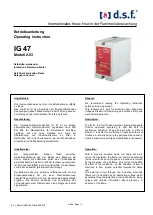
Protection Functional Tests
Protection Functional Tests
This section details the procedures for testing each protection function of the 7SR5 relays. These tests are typi-
cally carried out by secondary injection to verify the correct operation of the associated input and output func-
tionality, and communications protocol information for protection operations and logic and can be used to
confirm that the pick-ups levels and time delays are as expected for the applied settings if this is required for
scheme approval testing.
Guidance for calculating test input quantities is given in the relevant test description where required. In many
cases it may be necessary to inhibit some functions during the testing of others, this prevents any ambiguity
caused by the operation of multiple functions from the same of input quantities. The
Function Config
menu provides a convenient high level point at which all elements of a particular function can be
Enabled/
Disabled
to suit testing. The
Config
tab in Reydisp Evolution can be used to
Enable/Disable
individual
elements. Note that this screen disables functions by applying setting changes to the relay and that any
changes must be sent to the relay to take effect and settings must be returned to their correct value after
testing.
Any LED can be assigned to be a
General Pickup
LED in the
Output Matrix
menu and used to assess
operation of functions during testing if other functions are disabled or if the setting allocating
General
Pickup
is temporarily modified.
Voltage inputs may not be required for testing of non-directional overcurrent elements but it may be advanta-
geous to apply balanced 3 phase nominal rated voltage to the VT inputs during testing to avoid inadvertent
operation of other functions. Particular care should be taken when testing overcurrent functions that the
thermal rating of the current inputs is not exceeded.
It should be considered that where several overlapping elements are used simultaneously, the overall protec-
tion operate time may be dependent on the operation of different individual elements at the various levels of
applied current or voltage. The resulting composite characteristic may be tested by enabling all of the relevant
applicable elements or the element operations can be separated or disabled and tested individually.
All relay settings should be checked before testing begins. It is recommended that the relay settings are
extracted from the relay using Reydisp Evolution software and a copy of these settings is stored for reference
during and after testing. It may be necessary to disable some protection functions during the testing of other
functions to allow unambiguous results to be obtained.
Care must be taken to reset or re-enable any settings that have been temporarily altered during the testing
before the relay can be put into service. At the end of testing the relay settings should be compared to the file
extracted at the start to ensure that errors have not been introduced.
21LB Load Blinder
Load blinders are designed to block overcurrent elements from tripping in heavy load conditions. User settings
21LB 3Ph Angle +ve, 21LB 3Ph Angle -ve, and 21LB 3Ph impedance allow users to define the blinder region
depending on the networks or line’s loading and fault limits. The 3Ph impedance is the positive sequence
impedance which is specified in secondary Ω and can be calculated by the phase to neutral voltage divided by
the phase current
Determining Load Blinder Regions (21LB)
Apply balanced 3 phase rated voltage and balanced current in phase with the phase to neutral voltages.
Current level should be selected such that the impedance calculated from Van/Ia is greater than the 21LB 3Ph
impedance setting. Typically 0.5 ⋅ I
rated
. The
Load Blinder FWD
signal should be active.
Increase the angle of the 3 phase currents in a leading (positive) direction. This will approach the
Forward
(+)
boundary defined by the Angle +ve setting. The
Load Blinder FWD
signal will reset when the angle is
above the setting plus 3° hysteresis and will pickup again if the angle is reduced to below the Angle +ve
setting.
Increase the angle of the 3 phase currents in a lagging (negative) direction. This will approach the
Forward
(-)
boundary defined by the Angle -ve setting. The
Load Blinder FWD
signal will reset when the angle is above
the setting plus 3° hysteresis and will pickup again when the angle is reduced to below the Angle -ve setting.
9.10
9.10.1
Functional Tests
9.10 Protection Functional Tests
Reyrolle 7SR5, Transformer Protection Device, Device Manual
421
C53000-G7040-C015-1, Edition 11.2019
Содержание Reyrolle 7SR5
Страница 8: ...8 Reyrolle 7SR5 Transformer Protection Device Device Manual C53000 G7040 C015 1 Edition 11 2019 ...
Страница 24: ...24 Reyrolle 7SR5 Transformer Protection Device Device Manual C53000 G7040 C015 1 Edition 11 2019 ...
Страница 132: ...132 Reyrolle 7SR5 Transformer Protection Device Device Manual C53000 G7040 C015 1 Edition 11 2019 ...
Страница 142: ...142 Reyrolle 7SR5 Transformer Protection Device Device Manual C53000 G7040 C015 1 Edition 11 2019 ...
Страница 338: ...338 Reyrolle 7SR5 Transformer Protection Device Device Manual C53000 G7040 C015 1 Edition 11 2019 ...
















































